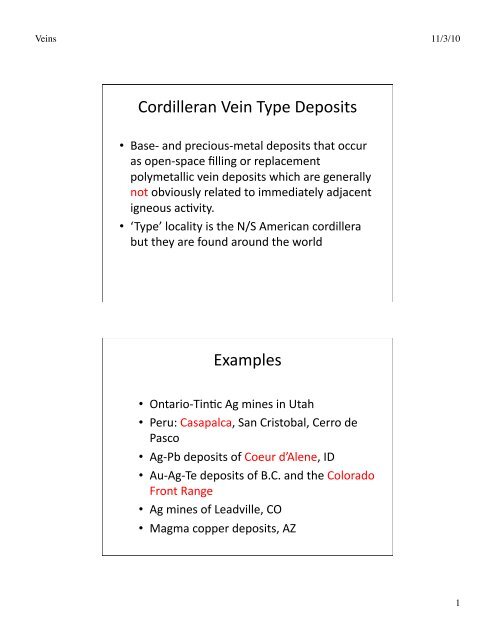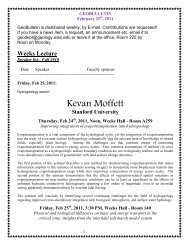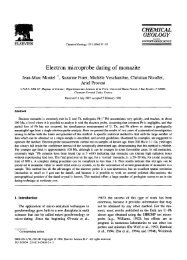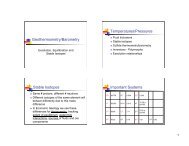Cordilleran Vein Type Deposits Examples
Cordilleran Vein Type Deposits Examples
Cordilleran Vein Type Deposits Examples
Create successful ePaper yourself
Turn your PDF publications into a flip-book with our unique Google optimized e-Paper software.
<strong>Vein</strong>s 11/3/10<br />
<strong>Cordilleran</strong> <strong>Vein</strong> <strong>Type</strong> <strong>Deposits</strong><br />
• Base-‐ and precious-‐metal deposits that occur<br />
as open-‐space filling or replacement<br />
polymetallic vein deposits which are generally<br />
not obviously related to immediately adjacent<br />
igneous ac>vity.<br />
• ‘<strong>Type</strong>’ locality is the N/S American cordillera<br />
but they are found around the world<br />
<strong>Examples</strong><br />
• Ontario-‐Tin>c Ag mines in Utah<br />
• Peru: Casapalca, San Cristobal, Cerro de<br />
Pasco<br />
• Ag-‐Pb deposits of Coeur d’Alene, ID<br />
• Au-‐Ag-‐Te deposits of B.C. and the Colorado<br />
Front Range<br />
• Ag mines of Leadville, CO<br />
• Magma copper deposits, AZ<br />
1
<strong>Vein</strong>s 11/3/10<br />
Generaliza>ons -‐1<br />
• Associa>on in space and >me with calc-‐<br />
alkaline igneous ac>vity<br />
• Hydrothermal transport of ore components,<br />
deposited epigene>cally in faults<br />
• Ore minerals as typical open-‐space fillings<br />
or co-‐precipitates in silicate host rocks and<br />
as replacements in carbonate hosts<br />
• Deposi>on within 1+ km of the surface<br />
• Well developed metal zona>on<br />
Generaliza>ons-‐2<br />
• Sulfur isotope ra>os close to 0 ‰<br />
• Structural control<br />
• Typically well-‐developed bilaterally<br />
symmetrical wall-‐rock altera>on<br />
• Normally contain porphyry-‐Cu suite of<br />
elements with zona>on from (Sn-‐W-‐)Mo-‐<br />
Cu-‐Zn-‐Pb-‐Mn-‐Ag<br />
• Magma>c-‐hydrothermal fluids mixed (late,<br />
post-‐ore?) with meteoric fluids<br />
2
<strong>Vein</strong>s 11/3/10<br />
Casapalca, Peru<br />
3
<strong>Vein</strong>s 11/3/10<br />
Casapalca, Peru<br />
• Mineraliza>on in a series of veins<br />
• <strong>Vein</strong>s cut series of N-‐S an>clines and<br />
synclines in Cretaceous ls; 1500m of<br />
Ter>ary subaerial Casapalca Fm; 1500m of<br />
andesi>c tuffs, flows, and volcaniclas>c<br />
sediments and 1500m of pre-‐Miocene<br />
sediments and volcanic rocks<br />
• Principal C vein N45°E, dips 70-‐80 NW<br />
– Other veins subparallel; or as splays<br />
4
<strong>Vein</strong>s 11/3/10<br />
5
<strong>Vein</strong>s 11/3/10<br />
Casapalca Structures<br />
• Miocene folding and diori>c intrusions<br />
• Major intrusion cut by mineralized fault -‐<br />
complicated history<br />
• Liile skarn in district<br />
– Found in the 11km Graton Tunnel driven below<br />
the workings to drain water (up to 66°C),<br />
ven>late, haulage<br />
• <strong>Vein</strong>s occupy shear planes -‐ 6 km long, 2<br />
km high<br />
6
<strong>Vein</strong>s 11/3/10<br />
7
<strong>Vein</strong>s 11/3/10<br />
Timing, temperature, mineralogy,<br />
zona>on<br />
• See figure<br />
– Py-‐Sphalerite-‐Galena-‐(huebnerite-‐<br />
arsenopyrite) early at 350-‐400° C<br />
– Chalcopyrite, then Tetrahedrite follow, ZnS-‐PbS<br />
begin to wane<br />
– Pyrite and quartz gangue<br />
– Late sulfides strongly zoned: both<br />
mineralogically and composi>onally<br />
– Altera>on is extensive centrally becoming less<br />
intense and localized outward<br />
8
<strong>Vein</strong>s 11/3/10<br />
Timing, temperature, mineralogy,<br />
zona>on (cont.)<br />
• Chalcopyrite abundant in center, Sb-‐As-‐Bi<br />
sulfosalts take over peripherally<br />
• 4-‐40% NaCl, varied erra>cally, minor boil<br />
• Average ore grade:<br />
– 2% Pb 3% Zn<br />
– 0.3% Cu 10 oz/ton (310 ppm) Ag<br />
• <strong>Vein</strong>s up to 1 meter wide<br />
– Important small adjacent parallel fractures<br />
9
<strong>Vein</strong>s 11/3/10<br />
10
<strong>Vein</strong>s 11/3/10<br />
Cerro de Pasco, Peru<br />
Buie, Montana<br />
11
<strong>Vein</strong>s 11/3/10<br />
Colorado Telluride Belt<br />
• NE end of the Colorado Mineral Belt<br />
• Placer gold discovered in 1859<br />
• Au-‐Te ores discovered in 1872<br />
• Small, erra>cally distributed, rich ore bodies<br />
• Mined un>l about 1960<br />
• Te not recovered from these ores -‐ Te<br />
recovered during Cu refining (porphyries)<br />
12
<strong>Vein</strong>s 11/3/10<br />
Geologic Seong<br />
• Precambrian schist and gneiss intruded by<br />
Ter>ary stocks & dikes<br />
• Te mineraliza>on related to dikes and<br />
intrusion breccias<br />
• Localized where NW ‘breccia reefs’ intersect<br />
NE veins<br />
13
<strong>Vein</strong>s 11/3/10<br />
14
<strong>Vein</strong>s 11/3/10<br />
Ore <strong>Deposits</strong> -‐ Mul>ple Events<br />
• Pb-‐Ag deposits: widely scaiered veins (NE)<br />
– (Pb,Ag)S, tetrahedrite, ± sph, cpy, py<br />
• Fluorite deposits: Jamestown<br />
– 1-‐20’ wide veins, 100-‐1000’ long<br />
– Adjacent to sodic grani>c stocks<br />
– Deep violet color: up to 0.05% U<br />
• Pyri>c Au deposits: NE trending veins<br />
– Coarse pyrite, cpy, sph, gal, tetrahedrite<br />
– Earlier than Au-‐Te event<br />
Mul>ple Events -‐ con>nued<br />
• Au-‐Te deposits: NE trending fissures<br />
– Inches to feet thick, mined to 3-‐700’ depth<br />
– Ore con>nues at depth but water and Au price<br />
made non-‐economic<br />
– Best ore in breccia zones<br />
– Petzite, hessite, sylvanite, calaverite, …<br />
• Tungsten deposits: E-‐NE belt overlapping<br />
end of Te belt<br />
– Fe-‐Mn tungstates (ferberite)<br />
15
<strong>Vein</strong>s 11/3/10<br />
16
<strong>Vein</strong>s 11/3/10<br />
Coeur D’Alene, Idaho<br />
• One of the largest Ag districts in the world<br />
• $3+ billion of ore since 1879<br />
– 1 billion oz of Ag<br />
– 10 million tonnes of Pb<br />
– 3 million tonnes of Zn<br />
– 200,000 tonnes of Cu<br />
– Significant Sb<br />
17
<strong>Vein</strong>s 11/3/10<br />
• 50 x 20 km area<br />
• District-‐wide zoning<br />
– Au in north<br />
– Pb-‐Zn in center<br />
– Cu-‐Ag in south<br />
• Underlain by:<br />
General Seong<br />
– Proterozoic Belt Group<br />
– Cretaceous igneous intrusions<br />
– Ter>ary and Quaternary unconsolidated units<br />
Belt Group<br />
• Quartzites, argillites and calcareous rocks<br />
up to 6km thick<br />
• Shallow water origin<br />
– Mud cracks, ripples, stromatolites<br />
• Folded, faulted and minor metamorphism<br />
in Proterozoic and during Laramide<br />
– Monzonite stocks and lamprophyre dikes and<br />
sills were intruded aver Mesozoic deforma>on<br />
– Minor diabase sills appear to be Precambrian<br />
18
<strong>Vein</strong>s 11/3/10<br />
Faul>ng<br />
• WNW faults, the major being:<br />
• Osburn Fault can be traced for hundreds of<br />
kms outside of district<br />
– Dips 55-‐65° south<br />
– 4.5 km normal dip-‐slip offset<br />
– 25 km right lateral strike slip displacement<br />
– Intermiiently ac>ve since Precambrian<br />
– 30-‐60 m wide fault zone<br />
– Many parallel and oblique 2nd order faults<br />
19
<strong>Vein</strong>s 11/3/10<br />
Ore deposits<br />
• Most in fractures and shears in Belt rocks<br />
– Minor structures more favorable than major<br />
• Some ore in monzonites, lamprophyres<br />
unmineralized<br />
• Briile rocks more highly mineralized<br />
• Galena, sphalerite, tetrahedrite,<br />
chalcopyrite, pyrrho>te, magne>te,<br />
arsenopyrite<br />
– Minor bornite, chalcocite, s>bnite, Cu-‐Sb-‐S<br />
sulfosalts, scheelite, uraninite<br />
Ores (cont)<br />
• Arsenopyrite forms envelopes around ore<br />
• Qtz, siderite, pyrite, (barite) as gangue<br />
– Typical ‘mesothermal’ assemblage<br />
• 10% combined Pb-‐Zn; 1 oz/tonne Ag<br />
• Ag in tetrahedrite, not galena<br />
20
<strong>Vein</strong>s 11/3/10<br />
Timing or Mineraliza>on<br />
• Very confusing and s>ll debated<br />
– Some may be Precambrian<br />
– Most probably syn-‐ post-‐Laramide<br />
– Some stocks seem directly implicated<br />
– Pb age is Precambrian -‐ remobilized from Belt<br />
basement by Laramide hydrothermal systems?<br />
– No single paragenesis for district as whole<br />
– Altera>on variable -‐ sericite most common<br />
Cobalt, Ont. Loca>on Map<br />
21
<strong>Vein</strong>s 11/3/10<br />
Cobalt, Ontario -‐ Summary 1<br />
• 445 million oz Ag since 1903<br />
• Na>ve Ag w/ cobalt arsenides and sulfosalts<br />
• Near ver>cal carbonate veins cuong<br />
– Huronian Gowganda<br />
– Archean metavolcanics<br />
– Nipissing diabase<br />
• All major deposits within a few hundred<br />
meters of the Archean unconformity and in<br />
proximity to diabase and VMS sulfide<br />
mounds in the Archean metavolcanics<br />
22
<strong>Vein</strong>s 11/3/10<br />
Cobalt, Ontario -‐ Summary 2<br />
• Ag mobilized from country rocks by<br />
hypersaline brines and deposited by mixing<br />
with cooler meteoric water<br />
• Chloride complexing dominant<br />
• Halite-‐bearing fluid inclusions<br />
• 300-‐350° C<br />
• 600-‐1360 bars (2-‐4 km lithosta>c depth)<br />
23





